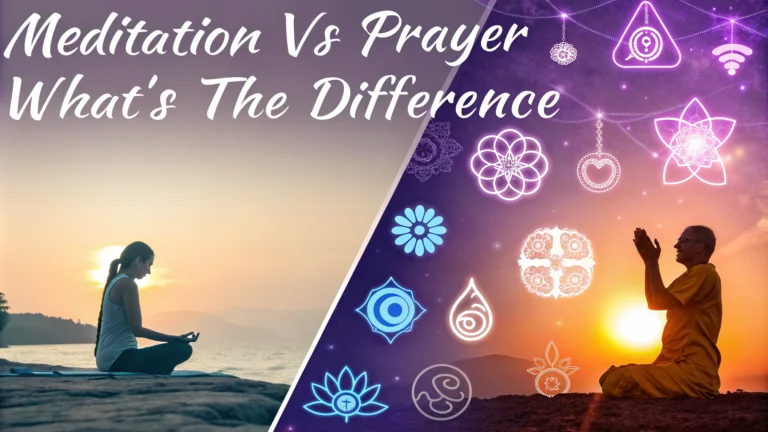Many people seek deeper spiritual connections and inner peace through **meditation** and **prayer**, yet these practices often get mixed up. While both offer paths to personal growth and reflection, they serve different purposes and originate from distinct traditions.
**Meditation** focuses on mindfulness and self-awareness, while **prayer** typically involves communication with a higher power. These powerful practices can work separately or together to enhance spiritual well-being and mental clarity.
Key Differences Between Meditation and Prayer
**Core distinctions** between these practices shape how they’re performed and their intended outcomes:
- **Intent**: Meditation aims for mental clarity; prayer seeks divine connection
- **Direction**: Meditation looks inward; prayer reaches outward
- **Structure**: Meditation often follows specific techniques; prayer can be more freestyle
- **Origins**: Meditation stems from Eastern traditions; prayer exists in most religions
Benefits of Regular Meditation Practice
- **Stress reduction** and lower anxiety levels
- **Improved focus** and concentration
- **Better emotional regulation**
- **Enhanced self-awareness**
- **Reduced blood pressure**
The Power of Prayer in Daily Life
**Prayer** offers unique benefits that complement or stand apart from meditation:
- **Spiritual connection** and guidance
- **Community bonding** through shared beliefs
- **Emotional release** and comfort
- **Gratitude practice**
- **Moral compass** development
“Prayer is asking for guidance. Meditation is listening for the answer.” – Unknown
Integrating Meditation and Prayer into Daily Life
While each practice offers unique benefits, **combining meditation and prayer** can create a more complete spiritual toolkit for managing daily challenges and fostering personal growth.
Creating a Balanced Practice Routine
A well-structured approach helps build consistency and maximizes the benefits of both practices.
- **Morning meditation** (10-15 minutes) for mental clarity
- **Evening prayer** for reflection and gratitude
- **Mindful breaks** throughout the day
- **Weekly group sessions** for community connection
Common Obstacles and Solutions
Understanding typical challenges helps develop effective strategies for maintaining regular practice.
| Challenge | Solution |
|---|---|
| Limited time | Start with 5-minute sessions |
| Mind wandering | Use guided audio or mantras |
| Inconsistency | Set daily reminders |
| Lack of focus | Create a dedicated space |
Building Your Personal Practice
Design a practice that aligns with your beliefs and lifestyle goals.
- **Choose specific times** for each practice
- **Select comfortable positions** that work for you
- **Start small** and gradually increase duration
- **Track progress** through a journal
- **Join like-minded groups** for support
“The quieter you become, the more you can hear.” – Rumi
Remember that both meditation and prayer are personal journeys that evolve over time. Focus on what resonates with you rather than following strict rules or expectations.
Recommended Resources
- Meditation apps (Headspace, Calm)
- Local spiritual centers
- Online communities
- Books on mindfulness and spirituality
FAQs About Meditation and Prayer
Basic Differences
Q: What is the main difference between meditation and prayer?
A: Prayer typically involves communicating with a higher power or deity, while meditation focuses on awareness of one’s own mind and thoughts, often without any religious context.
Q: Can meditation and prayer be practiced together?
A: Yes, many religious traditions combine both practices. Examples include Christian contemplative prayer, Islamic Sufi meditation, and Buddhist prayer meditation.
Practical Aspects
Q: Does meditation require a specific religious belief?
A: No. While meditation is part of many religions, secular meditation practices like mindfulness are independent of any religious beliefs.
Q: Which practice is better for reducing anxiety – meditation or prayer?
A: Both can reduce anxiety, but research shows:
- Meditation: Directly affects stress hormones and brain activity
- Prayer: Provides emotional comfort and community support
Q: How long should beginners practice meditation vs prayer?
A: Start with:
| Practice | Recommended Time |
|---|---|
| Meditation | 5-10 minutes daily |
| Prayer | No set time – can be brief or extended |
Scientific and Spiritual Aspects
Q: What are the brain benefits of meditation vs prayer?
A: Brain scans show both practices affect different areas:
- Meditation: Increases gray matter in attention and emotional regulation areas
- Prayer: Activates reward circuits and social cognition regions
Q: Can meditation replace traditional prayer in religious practice?
A: While meditation can complement prayer, most religious authorities view prayer as irreplaceable for spiritual connection.
Q: Is mindfulness meditation the same as contemplative prayer?
A: No. Mindfulness meditation focuses on present-moment awareness, while contemplative prayer involves focused communion with God/divine.
Q: Which helps more with sleep – meditation or prayer before bed?
A: Both can aid sleep, but meditation typically includes specific techniques for relaxation and sleep preparation.
Q: What are the different postures for meditation vs prayer?
A: Common positions include:
- Meditation: Cross-legged, kneeling, lying down
- Prayer: Kneeling, standing, prostrating, hands folded
Q: How do meditation and prayer affect blood pressure differently?
A: Studies show both practices can lower blood pressure through stress reduction, but meditation has more documented clinical evidence.



















